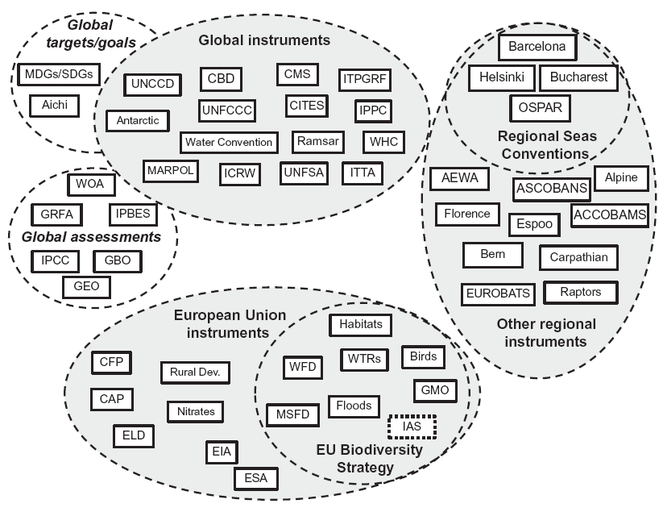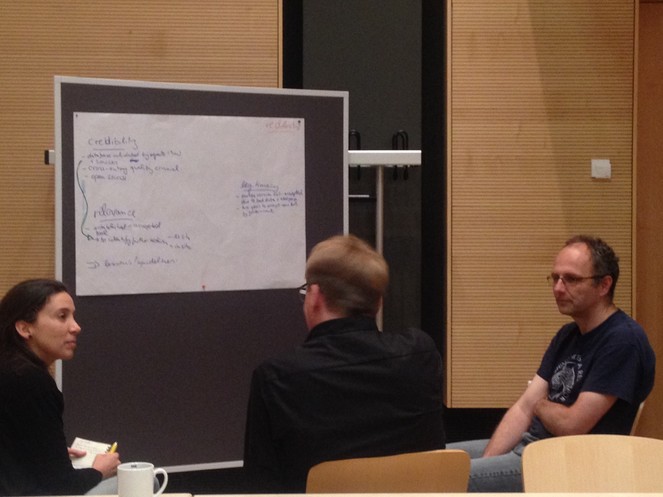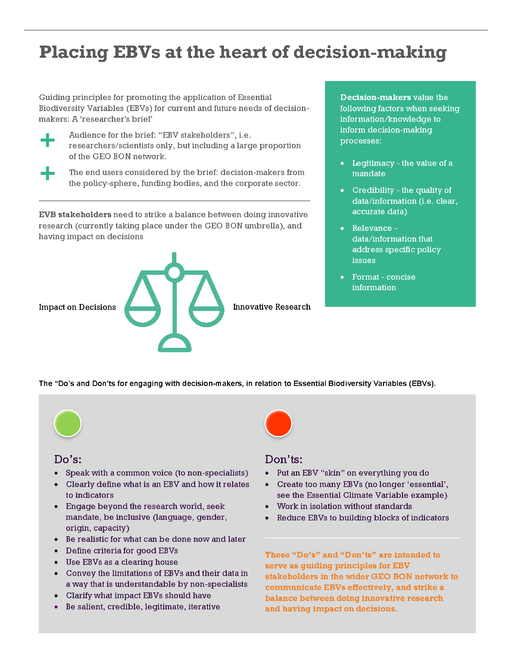|
Research Ideas and Outcomes : Workshop Report
|
|
Corresponding author: Katherine Despot-Belmonte (katherine.despot-belmonte@unep-wcmc.org)
Received: 07 Feb 2017 | Published: 14 Feb 2017
© 2017 Katherine Despot-Belmonte, Carsten Neßhöver, Hannu Saarenmaa, Eugenie Regan, Carsten Meyer, Eline Martins, Quentin Groom, Anke Hoffmann, Alessandra Caine, Nadine Bowles-Newark, Haejin Bae, Dora Ann Lange Canhos, Stefanie Stenzel, Diana Bowler, Aline Schneider, Lauren V. Weatherdon, Corinne S. Martin
This is an open access article distributed under the terms of the Creative Commons Attribution License (CC BY 4.0), which permits unrestricted use, distribution, and reproduction in any medium, provided the original author and source are credited.
Citation: Despot-Belmonte K, Neßhöver C, Saarenmaa H, Regan E, Meyer C, Martins E, Groom Q, Hoffmann A, Caine A, Bowles-Newark N, Bae H, Canhos D, Stenzel S, Bowler D, Schneider A, V. Weatherdon L, S. Martin C (2017) Biodiversity data provision and decision-making - addressing the challenges. Research Ideas and Outcomes 3: e12165. https://doi.org/10.3897/rio.3.e12165
|

|
Abstract
Essential Biodiversity Variables (EBVs) are measurements required for study, reporting, and management of biodiversity change. They are being developed to support consistency, from the collection to the reporting of biodiversity data at the national, regional and global scales. However, "EBV stakeholders" need to strike a balance between 'doing innovative research' and 'having positive impact' on biodiversity management decisions. This paper reports on a workshop entitled Identifying joint pathways to address the challenges of biodiversity data provision and decision-making and presents the main workshop’s output, a “researcher’s brief” entitled Guiding principles for promoting the application of EBVs for current and future needs of decision-makers. These guiding principles are: Speak with a common voice; Clearly define what is an EBV and how it relates to indicators; Engage beyond the research world; Be realistic about what can be done now and later; Define criteria for good EBVs; Use EBV as a clearing house; Convey the limitations of EBVs; Clarify what impact EBVs should have; Be salient, credible, legitimate, iterative; Don't put an EBV skin on everything you do; Don't create too many EBVs; and Don't reduce EBVs to building blocks of indicators. This brief is of relevance to the wider GEO BON (Group on Earth Observation Biodoversity Observation Network) community, and in particular those scientists/researchers interested in the application of EBVs.
Keywords
biodiversity data, knowledge products, science-policy interface, GEO BON, EU BON, EBVs, EKLIPSE mechanism
Introduction
This report provides a summary of the joint EU BON - EKLIPSE workshop which took place during the 2016 GEO BON (Group on Earth Observation Biodiversity Observation Network) ‘Open Science Conference & All Hands Meeting’ (4-8 July, Leipzig, Germany, http://conf2016.geobon.org/). This four day event was attended by a few hundreds biodiversity experts ranging from scientists and researchers of museums, universities and nationally-funded centres, to conservation practitioners (from Non- and Inter-Governmental Organisations, the private sector, etc). During the ‘All Hands Meeting’, UNEP-WCMC (United Nations Environment Programme World Conservation Monitoring Centre) and UFZ (Helmholtz Centre for Environmental Research), as part of their respective “EU BON” and “EKLIPSE” projects, co-hosted a workshop entitled Identifying joint pathways to address the challenges of biodiversity data provision and decision-making.
The EU BON (“Building the European Biodiversity Observation Network”, (
One main focus of the ‘Open Science Conference & All Hands Meeting’ was for participants to discuss the implementation of Essential Biodiversity Variables (EBVs). EBVs are defined “as a measurement required for study, reporting, and management of biodiversity change” (
Background information and aims of the workshop
Recent decades have seen major developments in the discoverability and accessibility of biodiversity data, with key players such as GEO BON, GBIF*
Both sides of the picture, i.e. ‘biodiversity data provision’ and ‘decision-making based on information/knowledge derived from biodiversity data’, have distinct but intertwined challenges that are often discussed and tackled independently. The joint EU BON – EKLIPSE workshop aimed to identify some of the challenges of turning biodiversity data into knowledge to support decision-making, and to identify possible pathways to make biodiversity data more relevant to decision-makers. The workshop had a global focus in order to make useful contributions to the GEO BON network, and potentially inform relevant international processes such as IPBES*
Key discussions and outcomes of the workshop
The workshop began with a series of short presentations to set the scene and to provide European and global perspectives on the challenges of ‘biodiversity data provision’ and ‘decision-making’ based on available data. The second part of the workshop was more interactive, and organised around two case studies where participants worked in groups to address the key challenges of biodiversity data provision to support decision-making.
Challenges of biodiversity data provision - presentation
Hannu Saarenmaa (University of Eastern Finland, EU BON) presented on the challenges of biodiversity data provision at the European scale. He highlighted that biodiversity data are compiled and stored by a number of organisations and initiatives but that only around 10-20% of these data are shared openly, despite most countries having signed up to the GEOSS Data Sharing Principles*
- working through the existing networks (systems of systems) to advance interoperability and data integration,
- developing links with a number of networks that provide data (e.g. GEOSS, GBIF, Long Term Ecological Research Network LTER, Lifewatch, DataONE),
- providing data hosting to make data available and discoverable,
- developing tools to mobilise, share and publish data (e.g. via GBIF),
- providing training to enable efficient processing of data from collection to dissemination.
EU BON has also recently launched the European Biodiversity Portal, which is a single interface for the provision of European biodiversity data and information.
Biodiversity data needs by European and global policies - presentation
Corinne Martin (UNEP-WCMC, EU BON) provided an overview of the biodiversity data needs by European and global policies, and the use of biodiversity data by decision-makers more broadly. The main users of biodiversity data are national governments, inter-governmental & non-governmental organisations, corporations/businesses, and research bodies. Users fall largely within these four categories (Fig.
Decision-makers use biodiversity for different purposes, and as such, their needs in terms of spatial scales and data formats vary. For example, researchers tend to use raw data for mapping, modelling and other analytical work. In contrast, national government officials may prefer data that have already been processed and packaged into an information product for policy-reporting and assessments. Thus, besides the three main issues of discoverability/accessibility/digestibility highlighted earlier, it is important to acknowledge that a certain expertise is often required to use data, which must be packaged into information and knowledge products (e.g. indicators, traffic-light maps, databases, decision-support tools, websites) and designed around the varying needs and capacity of end-users (e.g. decision-makers).
In the biodiversity policy context, the availability of comprehensive, sound, and up-to-date data is a key requirement to implement policies, strategies and actions to address biodiversity loss, monitor progress towards biodiversity targets, as well as to assess the current status and future trends of biodiversity. The biodiversity policy context is complex (Fig.
The provision of data, information and knowledge in Europe - presentation
Carsten Nesshöver (UFZ) provided an overview of the EKLIPSE project, which aims to set up a long-term, self-sustainable support mechanism for evidence-based and evidence-informed policy on biodiversity and ecosystem services for Europe (see www.eklipse-mechanism.eu for details). Currently, the best available science and expertise regarding biodiversity and ecosystem services are not being used effectively to inform policy-making in Europe. For example, it is said that around 80% of information and knowledge used to inform environmental policy in the European Union is provided via consultancy-based services contracts. However, there are experts and institutions that are willing to share relevant data and knowledge that informs policy-making processes. As such, the overall goal of the EKLIPSE project is to improve the interface between science, policy and society in order to support decision-making based on the best available knowledge (
The core tasks of the EKLIPSE project are as follows:
-
To build the underlying network of networks: develop the links with experts and institutions,
-
To build the capacity to get engaged: support engagement of network partners and individuals,
-
To synthesise knowledge, and to provide in-depth and high quality policy responses.
The roles of individuals and institutions are crucial to make this support mechanism self-sustainable after the funding phase (2020). For example, the mechanism needs to be set up to effectively answer policy-makers’ needs and concerns, and to add value to the decisions they need to make (
The EKLIPSE project is currently working on building the links between data providers and data users, as well as the links with similar platforms/mechanisms (e.g. the community platform on ecosystem services, OPPLA), thus identifying different roles for different knowledge providers in such mechanism.
Workshop outputs
The second part of the workshop focused on using the expertise of the room to identify pathways to address the aforementioned challenges in regards to biodiversity data provision and data-derived information use, and to produce an output of relevance to the wider GEO BON community. Participants were divided into two groups – the first group developed a case study on the first “Red Book” of Brazilian plants (Fig.
“Red Book” of Brazilian plants - The Botanic Gardens in Rio de Janeiro - case study
The National Centre for Flora Conservation/Botanic Gardens in Rio de Janeiro has the mandate to produce lists of threatened plant species under the oversight of Brazil’s Ministry of Environment. The so-called “Red Book” of Brazilian plants (
Placing EBVs at the heart of decision-making: a researcher’s brief - case study
Several group members (Fig.
Discussing the development of an EBV-based "researcher's brief"
b: Developing the brief
Conclusions
The joint EU BON – EKLIPSE workshop explored pathways to make biodiversity data useful in monitoring biodiversity trends, and communicating data-derived information to end-users (i.e. decision-makers). The following topics were covered: the importance of linking expert/research networks, promoting ongoing stakeholder engagement, addressing policy needs, and packaging data-derived information into concise formats. The main workshop output, a brief entitled Guiding principles for promoting the application of EBVs for current and future needs of decision-makers was then presented during the final plenary of the GEO BON All Hands Meeting, and was extremely-well received. As a result, this workshop has helped raise the importance of “science-policy interfacing in GEO BON”. The EU BON and EKLIPSE projects will continue to work together, and in this context their project Coordinators signed a Memorandum of Understanding to continue collaborating towards the provision of biodiversity data to inform policy-making processes.
Acknowledgements
This workshop report was supported by EU BON, a 7th Framework Programme project funded by the European Union (Contract No. 308454), and by EKLIPSE, a Horizon 2020 project funded by the European Union under the Framework Programme for Research and Innovation (Coordination and Support Actions, Contract No. 690474). We thank all participants for their contributions, and the GEO BON Secretariat for the opportunity to run the workshop during the 2016 GEO BON Open Science Conference & All Hands Meeting.
References
-
Taking stock of nature: Essential biodiversity variables explained.Biological Conservationhttps://doi.org/10.1016/j.biocon.2016.09.006
-
Bridging the gap between biodiversity data and policy reporting needs: An Essential Biodiversity Variables perspective.Journal of Applied Ecology53:1341‑1350. https://doi.org/10.1111/1365-2664.12417
-
Vision and goals. http://geobon.org/about/vision-goals/
-
The need for an integrated biodiversity policy support process – Building the European contribution to a global Biodiversity Observation Network (EU BON).Nature Conservation6:49‑65. https://doi.org/10.3897/natureconservation.6.6498
-
Biodiversity knowledge synthesis at the European scale: actors and steps.Biodiversity and Conservation25(7):1269‑1284. https://doi.org/10.1007/s10531-016-1143-5
-
Livro Vermelho da Flora do Brasil. [Red Book of Brazilian Flora].Instituto de Pesquisas Jardim Botânico do Rio de Janeiro,Rio de Janeiro. URL: http://dspace.jbrj.gov.br/jspui/handle/doc/26
-
The Network of Knowledge approach: improving the science and society dialogue on biodiversity and ecosystem services in Europe.Biodiversity and Conservation25(7):1215‑1233. https://doi.org/10.1007/s10531-016-1127-5
-
Ecology. Essential biodiversity variables.Science339(6117):277‑8. https://doi.org/10.1126/science.1229931
-
The roles and contributions of Biodiversity Observation Networks (BONs) in better tracking progress to 2020 biodiversity targets: a European case study.Biodiversity16:137‑149. https://doi.org/10.1080/14888386.2015.1075902
Global Biodiversity Information Facility, http://www.gbif.org/
Ocean Biogeographic Information System, http://www.iobis.org/
Intergovernmental Science-Policy Platform on Biodiversity and Ecosystem Services
Global Earth Observation System of Systems, https://www.earthobservations.org/geoss_dsp.shtml





